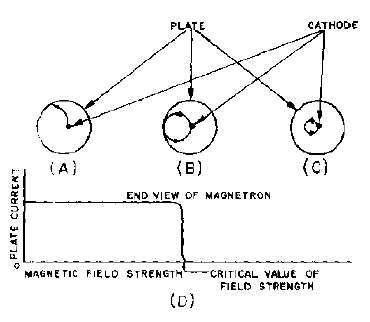2-28
Figure 2-22.—Effect of a magnetic field on a single electron.
In view (B) of figure 2-22, the magnetic field has reached a value great enough to cause the electron
to just miss the plate and return to the filament in a circular orbit. This value is the CRITICAL VALUE of
field strength. In view (C), the value of the field strength has been increased to a point beyond the critical
value; the electron is made to travel to the cathode in a circular path of smaller diameter.
View (D) of figure 2-22. shows how the magnetron plate current varies under the influence of the
varying magnetic field. In view (A), the electron flow reaches the plate, so a large amount of plate current
is flowing. However, when the critical field value is reached, as shown in view (B), the electrons are
deflected away from the plate and the plate current then drops quickly to a very small value. When the
field strength is made still greater, as shown in view (C), the plate current drops to zero.
When the magnetron is adjusted to the cutoff, or critical value of the plate current, and the electrons
just fail to reach the plate in their circular motion, it can produce oscillations at microwave frequencies.
These oscillations are caused by the currents induced electrostatically by the moving electrons. The
frequency is determined by the time it takes the electrons to travel from the cathode toward the plate and
back again. A transfer of microwave energy to a load is made possible by connecting an external circuit
between the cathode and the plate of the magnetron. Magnetron oscillators are divided into two classes:
NEGATIVE-RESISTANCE and ELECTRON-RESONANCE MAGNETRON OSCILLATORS.
A negative-resistance magnetron oscillator is operated by a static negative resistance between its
electrodes. This oscillator has a frequency equal to the frequency of the tuned circuit connected to the
tube.
An electron-resonance magnetron oscillator is operated by the electron transit time required for
electrons to travel from cathode to plate. This oscillator is capable of generating very large peak power
outputs at frequencies in the thousands of megahertz. Although its average power output over a period of
time is low, it can provide very high-powered oscillations in short bursts of pulses.
Q-31. The folded waveguide in a bwo serves the same purpose as what component in a twt?

